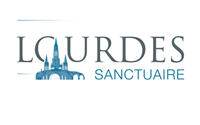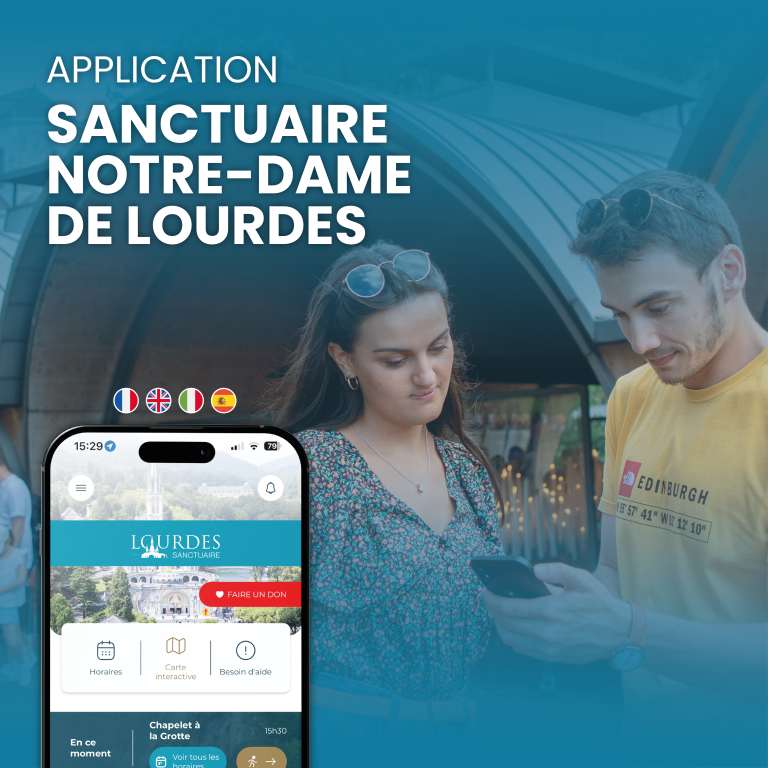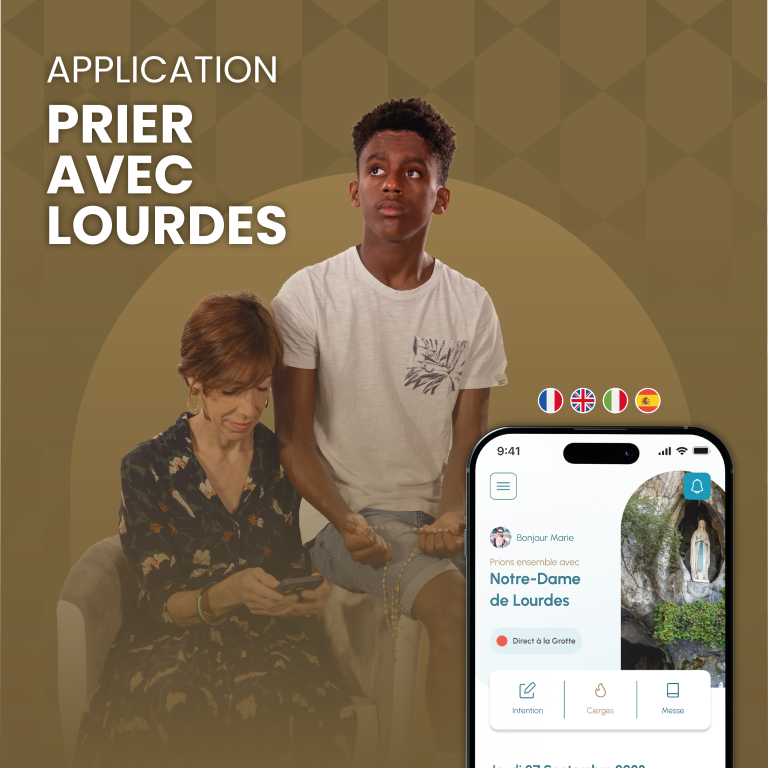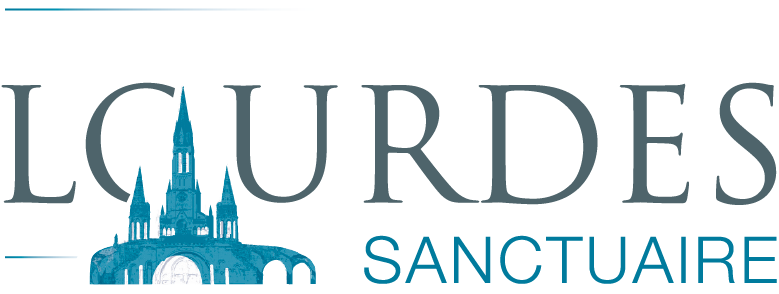Guidance of Mgr Brouwet, Bishop of Tarbes and Lourdes
In these pages I would like to give some guidelines for the future, so that together, chaplains and employees of the Sanctuary, hospitality members and pilgrimage directors, volunteers and partners of the Sanctuary can work to better fulfill the mission entrusted to us. My goal is to give a general direction to help in the discernment of our future plans and in the decisions that we make. Do not hesitate to raise these issues, not only at meetings in the Sanctuary, but also at pilgrimage conventions and Hospitality meetings!
“On the third day there was a wedding in Cana in Galilee, and the mother of Jesus was there. Jesus
and his disciples were also invited to the wedding. When the wine ran short, the mother of Jesus said to him, “They have no wine.” Jesus said to her, “Woman, how does your concern affect me? My hour has not yet come.” His mother said to the servers, “Do whatever he tells you.” Now there were six stone water jars there for Jewish ceremonial washings, each holding twenty to thirty gallons. Jesus told them, “Fill the jars with water.” So they filled them to the brim. Then he told them, “Draw some out now and take it to the headwaiter.” So they took it. And when the headwaiter tasted the water that had become wine, without knowing where it came from (although the servers who had drawn the water knew), the headwaiter called the bridegroom and said to him, “Everyone serves good wine first, and then when people have drunk freely, an inferior one; but you have kept the good wine until now.” Jesus did this as the beginning of his signs in Cana in Galilee and so revealed his glory, and his disciples began to believe in him.” [Gospel according to Saint John 2:1-11]
“Go and tell the priests that people should come here in procession, and that a chapel should be built here.” In the Sanctuary of Lourdes we are servants of the request made by the Virgin Mary to Bernadette on Tuesday 2 March 1858, during the thirteenth apparition.
What, therefore, is our mission?
- To welcome pilgrims by providing access to the Grotto and the spring, and accompanying them in the
footsteps of Bernadette under the guidance of Our Lady. - To build a Church by preaching the Gospel, and by celebrating the Sacraments of the Eucharist and
Reconciliation.
In this poor Grotto of Massabielle a corner of heaven touched the earth so that we may experience the
closeness, tenderness, and joy of God, of which Mary
is the face and the servant.
Our mission is to ensure that all those who come to the Sanctuary are touched, before the Grotto, by the unconditional love of Jesus. Our preaching, our projects, our initiatives, and our work should lead to that. This is the greatness of our responsibility: as at Cana, serving the joy of the guests under the guidance of Mary, to let the Lord do His work in our hearts; a work of mercy.
Our Sanctuary must be a place where men and women who come to the Grotto understand how much they are loved by God.
We should always return to this mission; deepening it, developing it, and adapting it to current circumstances.
Successive Bishops, rectors, chaplains and their collaborators have learned, since the apparitions, to serve pilgrims and understand their expectations, their thirst, their aspirations. They were able to explain the messages of Our Lady and understand the scope and urgency for their time. We inherit a long history of
celebrating the grace of God and preaching the Gospel. The 2008 Jubilee of the 150th anniversary of the apparitions of Mary to Bernadette showed the commitment of Catholics to the Sanctuary and its reputation in the world. It also showed vitality.
We have gained our experience in particular by working with pilgrimage organizations, whether diocesan or associations. Each year more than 600 of these groups come to Lourdes. They represent the “backbone” of our pilgrimage season and dictate the rhythm. It is thanks to them that hundreds of thousands of Christians come to the Grotto of Massabielle each year, often accompanied by their bishops.
These guidelines are the fruit of two year’s work with the Council of Lourdes, comprising chaplains and senior members of staff of the Sanctuary, who meet together every month.
1. Proclamation of the Gospel
During the coming years it is my wish that we focus our efforts on welcoming individual pilgrims, sick or disabled people, families and youth.
Individual pilgrims
We know well that the greater number of pilgrims who come are not in pilgrimages organised by a diocese
or association, but make their own arrangements. They are individuals, families, groups of friends. They
come to Lourdes for one or more days. Their pilgrimage is sometimes part of a larger trip: a holiday in
the Pyrenees, in France or Europe. Many already know the Sanctuary. But there are many people who come for the first time and who do not know the message of Lourdes. Among them some are baptized but know little about the Christian faith. Some are not Christians, belonging to other religions or have no beliefs.
We have a special responsibility with respect to these pilgrims. We must continue to welcome those who come on organized pilgrimages. But we need to think of new ways to welcome those who come individually, especially those who come to Lourdes without knowing what they will find or how they will experience those few hours or few days at the Grotto of Massabielle.
Let us start with an assumption: all those who enter the gates of Sanctuary have an expectation, a spiritual anticipation, because they know that in this place of apparitions heaven somehow touched the earth. But it is also a very real expectation as it relate to us, because they need to be supported in their approach.
I wish that, in the coming months, we think about this: how to welcome, support and provide the newness
of the Gospel to those who come on pilgrimage without knowing what Lourdes is about, without landmarks
in the Christian faith, sometimes without even knowing how to make the sign of the cross or pray the Our Father. How are we going to meet them as they are, respecting their own rhythm, but without fear of announcing Christ?
This is a true work of evangelization that requires availability, listening, patience and a pastoral sense.
It will obviously involve guiding the pilgrims to existing facilities such as the “day pilgrim” service or films presenting the message of Lourdes. But, above all, it will also be necessary to take time with just a few people, without seeking any return.
“I dream of a ‘missionary option’, that is, a missionary impulse capable of transforming everything”, wrote Pope Francis in his Apostolic Exhortation Evangelii Gaudium, “so that the Church’s customs, ways of doing things, times and schedules, language and structures can be suitably channeled for the evangelization of today’s world rather than for her self-preservation. The renewal of structures demanded by pastoral onversion can only be understood in this light: as part of an effort to make them more mission-oriented, to make ordinary pastoral activity on every level more inclusive and open, to inspire in pastoral workers a constant desire to go forth and in this way to elicit a positive response from all those whom Jesus summons to friendship with himself.” Evangelii Gaudium, 27.
This welcome, this evangelization, is certainly first and foremost the work of chaplains and religious brothers and Sisters. But it may also be that of volunteers, including young people who have the desire to proclaim Christ by offering a true Christian initiation.
I wish, in this regard, that we propose fundamental catechesis in the Sanctuary, to give an education in the faith to those who seek to advance in the Christian life. The Sanctuary of Lourdes is an ideal place to encourage and strengthen our relationship with Christ.
It is essential also that chaplains continue in the dynamism of the Year of Faith, to ensure the presence and
catechesis in the Grotto, at the baths and the spring, with the desire to show the pilgrims how much they
are loved by God. During the apparitions the Virgin Mary showed Bernadette the face of God’s tenderness for humanity. This tenderness, this concern, is particularly visible in the sacrament of confession and reconciliation, which is primordial in the pilgrimage to Lourdes.
In his Apostolic Exhortation Evangelii Gaudium, Pope Francis gives us the key catechesis to all our teach-
ing: “We have rediscovered the fundamental role of the first announcement or kerygma, which needs to
be the centre of all evangelizing activity and all efforts at Church renewal. The kerygma is Trinitarian. The fire of the Spirit is given in the form of tongues and leads us to believe in Jesus Christ who, by his death and
resurrection, reveals and communicates to us the Father’s infinite mercy. On the lips of the catechist the
first proclamation must ring out over and over: ‘Jesus Christ loves you; he gave his life to save you; and
now he is living at your side every day to enlighten, strengthen and free you.’ ”Evangelii Gaudium, 164.
Our objective is that each pilgrim should leave
Lourdes with this message of hope in the heart.
Sick and disabled people
In Lourdes they have pride of place. I think we can be proud of the manner in which they are welcomed, in
particular at the Accueil Notre-Dame, by the Sisters of Saint-Frai, and at the Salus Infirmorum of UNITALSI.
Why do the sick or disabled come to Lourdes? To make a pilgrimage in faith. Our mission is to make this
pilgrimage possible and fruitful. It is essential that each of them is involved, as far as possible, in the preparation of the pilgrimage, and that we know how to listen to them before, during and after the journey: attentive to their projects, their desires and expectations.
Do not forget that often these are sick or disabled people who evangelize the “able-bodied” people by their commitment to Christ in their prayer, their joy and trust in the Lord. They strengthen our hope. We have much evidence of this, very often from younger pilgrims.
In this regard, some pilgrimages seek to promote greater autonomy for the sick or disabled. It is true that
Lourdes has a long history of supporting these pilgrims, especially through the Brancardiers and all those who assist the residents of the different Accueils. But new initiatives emerge to give the sick people the greatest possible autonomy. Some groups offer them the possibility, for example, of staying in the hotel with valid pilgrims. I think we need to reflect, with all those who are engaged in these services, on these initiatives and our way of being present to the sick pilgrims.
Finally, we know that the number of sick people is decreasing slightly, especially those who are most
severely afflicted. This is partly due to the increasing difficulty in transporting them to the Sanctuary by rail. But there is another, deeper, reason: we hesitate to invite people with fragile health to Lourdes. In hospitals, clinics, nursing homes, the management is reluctant, in principle, to allow residents to travel. That is why it is families, visitors, and chaplaincy teams who, in an act of trust in God, must encourage them to go to Lourdes; not to expect a miracle, but to strengthen their faith, their hope, and their personal roots in the life of grace.
In collaboration with Hospitalities and directors of pilgrimages, we shall put forward proposals to dioceses and chaplaincies to facilitate the journey to Lourdes by the most vulnerable people.
Families
Families especially need to be supported and helped. Many of them seek places of healing in faith where
everyone, parents and children, may be encouraged in their Christian life. Bernadette’s personality, her humble spiritual journey under the guidance of Mary, the life of faith and prayer of the Soubirous family at the Boly Mill and the Cachot, and the climate of affection that reigned within it, are all subjects of meditation for families.
In cooperation with all the departments of the Sanctuary, the Cité Saint-Pierre, religious communi-
ties of Lourdes, guest houses and hotels, we shall see how we may accommodate families, particularly
those who lack financial resources to undertake such a journey. We should also work towards providing facilities for caring for young children to give parents the opportunity to take time for themselves.
Note that many grandparents take their grandchildren to Lourdes to help them discover this place of grace and healing during the holidays. We would also like to encourage and help organize such visits.
Young people
The Sanctuary is a real school of life for young people: through the liturgy, the service to the sick and disa-
bled, the experience of the universal Church. Lourdes is an ideal place to discover, live out or develop
the foundations of the Christian life: praising God, the sacramental life, the service to others – especially the
most fragile – opening to catholicity, meeting Christian communities in all their diversity, proximity to all
states of life, fraternal meetings with priests and bishops – pastors of the Church.
With the “Youth Service” of the Sanctuary, we will see how to develop new proposals, especially so that
young people may be ardent witnesses of the faith in Christ among their peers.
Understanding the needs of pilgrims
It seems necessary to develop a survey tool to know how pilgrims judge the quality of our reception and
facilities. It is very difficult to make decisions if we have no objective way of knowing those who come
to the Sanctuary and whether we are meeting their expectations. Without these investigative means our
reasoning is based on impressions or feelings that do not always correspond to reality. It is true that the
pilgrimage directors are valuable colleagues, but we also have to collect the opinions of those who do not
come in organized groups.
We should also expand our dialogue space on the internet to keep in touch with pilgrims, and to note
carefully their questions and suggestions, including those of a spiritual nature.
2. Internationalisation
The pilgrims from other continents are more and more numerous. They come in small groups or in
families; sometimes with sick people, and often with young children. They come from India, Sri Lanka,
Australia, the USA, Brazil, the Middle East, China, Korea, Japan, Africa…
Many of them come in contact with friends who live in religious communities in Lourdes (I am thinking here of the Korean, Lebanese and Chinese Sisters) and are thus introduced to the Sanctuary. We must continue
this effort to make the Sanctuary accessible and welcoming to pilgrims from all continents.
It is through our website that the message of Lourdes will be better understood, and also the opportunities for coming here on pilgrimage. I would like us to develop this site with versions in Arabic, Chinese and Portuguese.
With our online TV, our site can also be a help, a support, for those who cannot come to Lourdes and
yet want to be in communion with those who pray at the Grotto.
We need to rework the signage in the Sanctuary. To simplify it and indicate very clearly the most important
places connected with the pilgrimage. We should also consider the new languages so that all the pilgrims feel welcome. It will also be necessary to have leaflets containing a summary of the message of Lourdes available in these languages.
We must also continue the work that has been done to integrate the diversity of languages in the liturgy and
in processions. Besides the French, Italian, English and Spanish, we should always be attentive to majority
groups present, to provide a reading, prayer intentions or part of the Rosary in their language.
However care must be taken not to prolong the ceremonies by repeated readings in the Mass. Translation of
texts on screen may suffice.
Generally speaking different languages must be welcomed to the extent of our ability. But the use of these
languages should never take precedence over the proper conduct of the liturgy, its beauty, its simplicity or
its compliance with the rituals.
Be attentive, moreover, that languages do not come into competition with each other. I ask everyone to be
understanding about this and not to develop a spirit of discontent and division. It is the Spirit of Pentecost
which should animate us and not the dispersion of Babel. (Gen. 11:1-9).
3. The development of the area of the Grotto
The area of the Grotto – from the Rosary Esplanade to the bridge beyond the baths – is the
heart of our Sanctuary. There are so many pilgrims precisely because the place lends itself to re-
ceiving the grace of Lourdes. The place of the Apparitions is easily accessible; it is open to the heavens (in
every sense of the word!). The pilgrims are welcomed onto the Esplanade as if into a mother’s arms. There
is no door to cross, no stairs to climb. They are there, immediately, on the spot where Bernadette stood be-
fore Mary. And with all those present, irrespective of their condition, they can offer up their prayers as poor
people before God.
We must take care of this place of grace. In the coming three years we would like to develop it in or-
der to:
- render the pilgrims’ path more coherent,promote silence and meditation at the Grotto,
- find solutions to the flow of groups during the season,
- give more harmony to the entire site. Working with an architectural firm, it seemed wise
to rethink this whole space even if the work will take several years for financial reasons. - The area between the esplanade of the Rosary and the Grotto will be designed as a preparatory
space for contemplation and silent prayer. We will remove not only the medal distributors and candle kiosks,
but also the taps, to avoid distractions and noise. This area will be planted with trees and invite silence. - The area in front of the Grotto will remain open to the sky. The layout of the ground will indicate this place of prayer and meditation. The furniture will be renewed as will the lighting of the Grotto.
- The area currently reserved for candles will be devoted to the gesture of drinking and washing that Mary asked of Bernadette, and which is part of the tradition of the pilgrimage to Lourdes. Pilgrims will therefore access the taps after their visit to the Grotto, which is more coherent. These new taps will not be designed to fill containers with Lourdes water. This area must be reserved for the gesture asked of Bernadette. Filling bottles and containers with water is not an act of prayer. It causes a lot of noise and movement. It may be done elsewhere; it remains for us to find a suitable place.
- The current storage place for candles will be replaced by a secondary sacristy for the Grotto. Indeed
the current sacristy is too small for a large number of concelebrants. The new building, equal in area to
the former, will also contain a rest area for Hospitality members. The sacristy will be refitted with a chapel
for the Blessed Sacrament. - The baths will remain where they are and will therefore not be moved to the other side of the Gave. We
shall review their interior design. We are also working on restructuring the waiting area in front of the baths. - A new bridge will be built in front of the baths. After this bridge, on the opposite bank of the Gave leading towards the Church of St. Bernadette, we will have the candle holders. They will form a chapel of light and allow pilgrims to place their individual candles (the larger candles will remain at their current location).
- The new bridge will therefore give pilgrims access to the chapel of light and allow them to return to the esplanade or exits without passing in front of the Grotto. This gateway will also allow all pilgrims residing Accueil Notre-Dame to go to the pool without having to go to the Grotto.
- Another bridge will be built later in front of the entrance to the Accueil Notre Dame, near the statue of St. John Mary Vianney, so that the residents of the Accueil will not have to go under the arches to get to their accommodation. All this of course must be done in collaboration with the State departments responsible for protective measures against flooding. In this regard studies are underway to examine ways in which to protect the most vulnerable areas in the case of future flooding.
4. A “place for the Church”
In the longer term, it seems necessary to rethink the area of the pavilions, the Chapelle Notre Dame and
the building housing the Bernadette museum and Communication Services. This area is located in a flood zone. We shall of course here also collaborate with the municipality of Lourdes and the services of the Prefecture. We shall also work with officials of the Hospitality of Our Lady of Lourdes and the Pavilions
to redevelop this area into a place where meetings, parties, and picnics can take place; in short, a living space for all pilgrims. The Sanctuary itself is more reserved for prayer and liturgy. We lack a place of
conviviality which could include rooms available to Church Movements and Services during the season,
and also facilities for informal meetings, and group or family celebrations or meals.
5. The structures of the Sanctuary
General organisation
In 2013 two projects were completed:- We regrouped the Services within the Sanctuary by sector. It became urgent to find a coherent organization to facilitate the work and collaboration of the twenty-two Services within the Sanctuary. The creation of these sectors allows greater autonomy, better coordination between them, and ease of communication, thanks to the Council of the Sanctuary which brings together the heads of each sector together with the Rector and the Financial Controller.
- The communication services were consolidated and an audit was carried out to clarify the objectives and organization of this department. In the coming years we shall be working towards further collaboration between the sectors and the services on the one hand, and also between the chaplains and heads of sectors. In addition, we are beginning to work on a more fruitful cooperation between employees and volunteers. We have a long experience of this in Lourdes: since the early pilgrimages, chaplains, employees, Religious Brothers and Sisters, and volunteers work together to receive pilgrims. We also need to clarify the responsibilities and methods of work between the Hospitality of Our Lady of Lourdes and the “Pilote” service. The aim of all this is to improve the quality of our welcome, and also to strengthen the spirit of service and fellowship between all those who work at the Sanctuary.
Development Department
We shall create a Department in the Sanctuary responsible for Development. This is a new function. The mission of this new service will be to raise awareness of the Sanctuary to the outside world, to work more closely with the economic players of the Region, and seek new revenue for the Sanctuary.- Raise awareness of the Sanctuary: to establish contacts with travel agencies to arrange visits to Lourdes by Christians from other continents.
- To work more closely with the economic players of the Region means to develop the necessary collaboration with Lourdes and its neighbouring towns, tourist offices, hotels, airport and tourist sites to coordinate our efforts to serve pilgrims.
- Finding new sources of revenue means not only seeking funds from French and foreign benefactors but also to develop, from the current bookshop, a small commercial business to ensure the financial stability of our Sanctuary.
A balanced budget
Even if the economic situation is fragile and the number of pilgrims is decreasing, we must imperatively achieve a balanced budget in 2015. We are therefore looking for new sources of income. We also expect the organized pilgrimages to assume their responsibilities by paying the participation required of them.
We shall also be vigilant about our spending, trying to rationalize our purchases and services for pilgrimages. As we have done in 2013, some people retiring will not be replaced. Perhaps we shall also, in the coming years, slightly reduce the number of seasonal positions. This will always be done with great attention to individuals and their particular circumstances.
6. Conclusion
I would like to thank all the staff and volunteers of the Sanctuary. After almost two years with you, I salute both your professionalism and availability in accommodating all the pilgrims. The economic crisis and floods on the one hand, the crisis of the Christian faith on the other hand, contributed to the decrease in the number of pilgrims. This does not prevent us from making plans and being inventive. Our Sanctuary has a future if it is faithful to the mission entrusted to it and if it understands the thirst of those who come to drink at the spring. It is precisely in times of crisis, doubt, and trials that we must welcome those who come to seek light and hope in the Sanctuary of Lourdes.
I would also like to thank all those who are our partners: the Hospitality of Our Lady of Lourdes and all the
other Hospitalities, Associations and Pilgrimage Directors, Religious congregations, our generous donors, the city of Lourdes, the Hautes Pyrenees and the Midi-Pyrenees. It is thanks to your cooperation, your efforts, your confidence and your love for Lourdes that we can accommodate so many pilgrims every year. We are happy to cooperate with you and we confirm our continued availability to you.
Finally I thank the Rector and all the Chaplains of the Grotto. Thank you for your ministry of preaching and
reconciliation! Thank you for the hope you give to the pilgrims by the celebration of the sacraments, by your
words, by your presence, for your prayers!
For you all I invoke the blessing of the Lord through the intercession of Our Lady of Lourdes and St. Bernadette.
In conclusion, for your reflection, I would like to leave you with the words of Pope Francis in his Apostolic Exhortation Evangelii Gaudium: “There is a Marian ‘style’ to the Church’s work of evangelization. Whenever we look to Mary, we come to believe once again in the revolutionary nature of love and tenderness (…) This interplay of justice and tenderness, of contemplation and concern for others, is what makes the ecclesial community look to Mary as a model of evangelization. We implore her maternal intercession that the Church may become a home for many peoples, a mother for all peoples, and that the way may be opened to the birth of a new world.”
Lourdes, 11 February 2014, Mgr Nicolas Brouwet, Bishop of Tarbes and Lourdes





